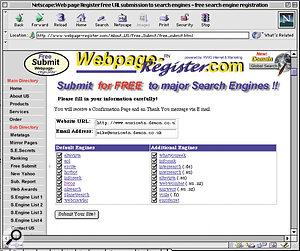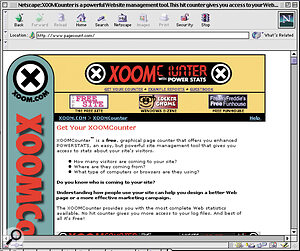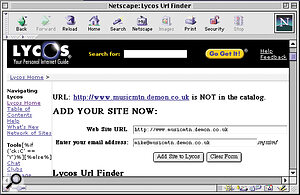Mike Simmons concludes his series on designing and constructing a web site by answering some of the many reader queries received in response to earlier instalments. This is the last article in a six‑part series.
Since I started this series, I've received a steady flow of emails from people wanting to know more — or not wanting to wait until next month's edition of Sound On Sound appeared on their doormat! In this final part, therefore, I thought I'd tackle a few of the most common questions I've been asked, but haven't yet covered in the series.
I see pictures on the Net in all sorts of shapes, but mine are all in boxes — how can I get a picture that's not box‑shaped?
If the image that you want to put on your site is a GIF, this can be very easily achieved. Many graphics programs will allow you to export or save a GIF with a transparent background. All you do is nominate which colour you want to be transparent, and then export the file in what's called GIF89a format. When such a file is imported into your web page, it will appear without a visible background. You need to be just a little careful here, since this will involve making every instance of the stipulated colour transparent, not just those occasions when the colour forms part of the background. Generally, however, any difficulties this causes can be avoided by selecting a background colour which does not appear anywhere in the image, and using that as your transparent background colour.
JPEGs do not offer the opportunity to create transparent backgrounds, however. One option is obviously to convert your JPEG into a GIF: if this doesn't result in a satisfactory image, the easiest solution is simply to use a background colour in your graphics program which is identical to the background colour you use on your web site. So, if you create a picture of a guitar on a black background you may well still have a square graphic, but once you insert it into your web page — which also has a black background — all your visitors will be aware of is a guitar‑shaped image. This trick can also work if you have a tiled background to your site, but might involve you in a little bit of trial and error. Simply import a copy of the background image into your graphics program and create your image on top of that. The trial and error involved takes place when you insert the image into your web page: you have to ensure that your graphic fits in with the other 'tiles'.
How do I get a counter onto my site?
Counters are dependent on something called a CGI (Common Gateway Interface) script. CGI scripts are small applications which actually run on the server on which your site is hosted, and it would be rare to find much CGI support coming with any basic ISP package. The exception to this rule is often the counter, and in many cases you'll find that your ISP provides this facility free of charge. The first step is simply to check with yours and, if they provide a counter CGI, follow their instructions for how you should use it.
...you don't just want to attract people to your site, you also want to keep them there for as long as possible once they've arrived.
If they don't provide this option then all is not lost, however, since there are a number of companies on the Internet who will let you use the CGI scripting on their server — usually in exchange for a small ad of some sort. If this appeals to you then you could try www.digits.com/ or www.pagecount.com/; a quick search on the web should turn up a number of such companies for you. This is inevitably a second‑best option, and is likely to slow your page down a little, but it will certainly work — at least while the server holding the CGI script is up and running. This server actually registers the hit when someone visits your site, and the HTML on your page picks up a graphics file which represents some form of counter which is displayed on your page.
How can I have a wallpaper background that changes as it goes across the page?
This effect is often used to replicate the spiral binding of an exercise book or a fade from one background colour to another. You need to use the same code as for any background (<BODY BACKGROUND="filename">), but make sure that the image you're calling up is very wide. If your 'tile' is wider than the viewer's browser window, then a new tile will be started at the left‑hand margin all the way down the page, giving the effect that you're looking for. How wide is wide? It's all down to the typical size and resolution of the monitor that your visitor is likely to be using; though something like 600 pixels will work for a lot of people, for others it will result in a pretty confused browser page. To really be on the safe side you might want to be thinking in terms of something like 1,200 pixels, since more and more people are moving away from the old standard 15‑inch monitor and are working at higher resolutions. Be careful here, though, since the wider an image is the larger the file will be, and the longer it will take to download, so make it as short as it possibly can be — if you can get away with a tile that's just five pixels high, so much the better.
How can I get a copyright sign onto my site?
Very easily. There is a whole range of what are called 'character entity codes' which will allow you to use fractions, accented letters, currency symbols — and the copyright sign. Just key in © (or ©, come to that) and you're there. Mind you, I'm not sure just how much protection the copyright symbol would be on the Internet...
Honey Trap
 Sites like Webpage‑Register.com allow you to submit your details to a number of the most important search engines simultaneously.
Sites like Webpage‑Register.com allow you to submit your details to a number of the most important search engines simultaneously. If your ISP doesn't provide you with a counter, you can always pick one up from elsewhere.
If your ISP doesn't provide you with a counter, you can always pick one up from elsewhere.
How can I get more people to visit my site?
Ah, the big question! First, of course, you need to make it worth visiting. That in itself is unlikely to be enough, however, since the world is full of people who have built a better mousetrap and are still waiting for someone to beat a path to their door. Having ensured that your site is worth the journey, the most obvious way of getting people to visit you is to tell them what your address is! I try to make mine pretty ubiquitous: I put it on all my album covers, and I put it on the signature of my emails. It's also on my letterheading and my invoices. I also swap links with other people from time to time, but I do try to ensure that there's some kind of relevance in making that swap. It can sometimes be a temptation to swap with just anyone, and as a result the Internet is swamped with vast lists of links which have very little coherence or logic.
The most important thing to do, however, is to register your site with a search engine or, to be more precise, with each and every search engine that you can possibly find. Search engines are, essentially, vast databases. When you enter a word or phrase into the space provided, the engine searches the database and comes up with pages that give a good match to the data you entered. Given that most people have a favourite engine, and that many of the new visitors to any site arrive as a result of carrying out a search, it makes sense to spread the word about your site as far and wide as you possibly can.
Most search engines have programs called 'spiders' which constantly trawl the web, following links and updating their databases accordingly. If a spider finds your site, therefore, it will be added to that search engine's database. However, this will only happen if it is able to follow a link to your site from another. As a consequence, if your site is new it may be a long time before this happens — and it won't happen at all if no‑one else has a link to your site.
 Most search engines offer a straightforward way of registering your site directly.However, most search engines also offer the facility to register via an interface on their site. If you go to any search engine you'll generally find a link somewhere named something like 'add URL' or 'add your site'. If you click on this, you'll be talked through the process of adding your site to their database. Some engines will simply ask you for your URL, while others will ask you to give them a few key words to describe your site and, perhaps, a brief overall description. Brief generally means 20 words or so, and if you decide to ignore this restriction you'll simply find that your description will be cut off in its prime. Make the 20 words count, and make sure that the keywords you use are the kind of thing that people might enter into a search engine if they were looking for a site like yours.
Most search engines offer a straightforward way of registering your site directly.However, most search engines also offer the facility to register via an interface on their site. If you go to any search engine you'll generally find a link somewhere named something like 'add URL' or 'add your site'. If you click on this, you'll be talked through the process of adding your site to their database. Some engines will simply ask you for your URL, while others will ask you to give them a few key words to describe your site and, perhaps, a brief overall description. Brief generally means 20 words or so, and if you decide to ignore this restriction you'll simply find that your description will be cut off in its prime. Make the 20 words count, and make sure that the keywords you use are the kind of thing that people might enter into a search engine if they were looking for a site like yours.
 There are a number of facilities on the web that will submit your site to a large number of engines. Very often they will operate a kind of two‑tier process where they will submit your site to a small number of engines for free, or a large number for a fee.
There are a number of facilities on the web that will submit your site to a large number of engines. Very often they will operate a kind of two‑tier process where they will submit your site to a small number of engines for free, or a large number for a fee.
Once you've submitted your site you'll generally receive a torrent of emails from the various search engines telling you that your site has been registered and/or will be visited (by a 'spider') in the next few days.
You can, if you want to, leave it at that, but if you take a little more time, you can influence the way in which your final entry will appear to anyone doing a search. You might remember that way back in part two of this series we brushed past META tags, and I promised that we'd come back to them some time in the future. This is that time. META tags sit between the <HEAD> and </HEAD> tags, and provide a wide range of information which a spider can use to categorise your site. The two most important META tags are 'description' and 'keywords'. If I show you how I've used them you'll get the idea of how they work. Here's the description from my site:
<META NAME="description" CONTENT="My name is Mike Simmons. I write music to dream to — warm, atmospheric music in which layers of natural and artificial sounds are used to create a pattern of slowly interweaving textures. It is ideal music for meditation, massage or relaxation.">
You can do exactly the same on your site, replacing all the text within the second pair of quotation marks with your own description. My keywords tag, which takes a similar form, is as follows:
<META NAME="keywords" CONTENT="New Age Music, Relaxing, Meditation, Ambient, Portmeirion, Aberdaron, Anelog, Bardsey Island, Music from the Mountains">
In both cases there should be no carriage returns, just one long string of text which is presented as one line. If you visit someone else's site and view it as source you'll see the way in which other people are using META tags to increase the chances of effective indexing of their sites.
One final thought: you don't just want to attract people to your site, you also want to keep them there for as long as possible once they've arrived. You'll do this by making your site interesting, of course, but also by making sure that it's up to date and not riddled with broken links. It might just about be acceptable to have an 'under construction' sign on your site for a day or two, but beyond that it just starts to look like an excuse for dodgy maintenance. Even if no‑one else visits your site it's imperative that you do, checking that everything still works and generally looking after it. This is one of the big advantages of creating your own site rather than paying someone else to do it — you can keep it up‑to‑date. If, for example, I visit your site in December and find only a gig list for the previous October I'm not likely to be very impressed — but I might well be interested in seeing some pictures that were taken at one of the gigs!
Final Thought
So that's just about it for web sites. I've barely scratched the surface in this series, and sometimes I've had to simplify things a little to make a point, but I hope I've given you some idea of just what's involved if you want to use up your free 5Mb (or 10, or 15) of server space. HTML is frustrating, gratifying and fun. It's also incredibly seductive. It's all too easy to find yourself doing something because it can be done, rather than because it's a good idea to do it. Your site can be whatever you want to make it — you can fill it with animations, flashing words and all manner of bells and whistles, or you can maintain a Zen‑like simplicity. Whichever you choose (and I know which one I'd go for!), I hope it helps you to get your music to a wider audience.
Super Online Sales
One of the most frequently asked questions I've heard is 'How do you manage to sell things on the web?'
Having a web site is a bit like having a shop; my albums are all out on display and potential customers can look at the covers, read the sleeve notes and even listen to some of the music. Where things get difficult is when they want to stop being potential customers, and become real ones instead. In the UK there's not too much of a problem since people can always send me a cheque, but further afield it's a bit of a nightmare unless you can take Visa or Mastercard. American visitors to my site have always been keen to send a cheque in dollars, but by the time the bank has had its cut for converting it from dollars to sterling there's not that much of it left for me, since they tend to operate a flat‑rate charge regardless of the amount that they're actually converting.
I've always felt that there was a bit of a business opportunity for some organisation to act as an agent, covering the financial and sales side of things and leaving the musician to handle the music. Those regular visitors to the wonderful SOS site (and if you're not a regular visitor you're really missing out on a lot) will have noticed that Sound On Sound is now doing just that...


